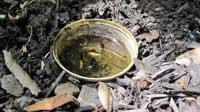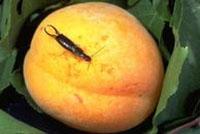Summer 2022
Earwigs - Good Bug? Bad Bug? Which is it?
The
European earwig, Forficula auricularia, known by children everywhere as a “pincher bug,” has become the most abundant earwig in California since it was first seen here in 1923. Earwigs are readily identifiable by their “pinchers,” which stick out from the tail end of their brownish-black bodies. In males, the pincers (or cerci, to entomologists) are curved like forceps, and in females, they are straight. They are omnivorous insects, and favor cool, moist, dark locations at ground level in which to hide during the day. According to the UC IPM Pest Note, they “feed on a variety of dead and living organisms, including insects, mites, and growing shoots of plants. They are voracious feeders on soft-bodied insects such as aphids and insect eggs, and can exert significant biological control under some circumstances.”
Earwigs make up the order of insects called Dermaptera, meaning “skin-wing.” Yes, they have wings, but they seldom use them—thank goodness! The name “earwig” comes from the Old English eare, which means ear, and wicga, which means beetle. Some entomologists think the name comes from the insect’s hindwing, which is shaped like a human ear. Despite that, many otherwise well-meaning people enjoy repeating the horrifying claim that they like to crawl into human ears and burrow into the brain to lay eggs. This is absolutely false! They are no more likely to enter your ear while you sleep than any other insect that might happen by.
If there is damage to tender seedlings in your flower or veggie beds, and you see earwigs about in your garden, it is possible they are causing the damage. The only way to be sure, though, is to go out at night when they are active and catch them in the act. If you don’t spot them, hold off on putting out any pesticides. There are other things that eat fresh new growth—including caterpillars, snails, slugs, and even birds.

If earwigs are indeed eating your plants, there are simple ways to thwart them. You can put out rolled, moistened newspaper or cardboard, or short pieces of hose near the plants before dark as a place to offer them shelter. Shake out any haplessly sheltering earwigs into soapy water in the morning. You can also trap them in a cat food or tuna can filled with ½-inch of vegetable oil and a bit of stinky fish oil or bacon grease as bait. For best effect, bury the cans so the top is at ground level. Cleaning away weeds, wood piles, dense ground cover, plant debris, or wood chip mulch from the area will take away possible hiding places. If you are lucky enough to have a friend or neighbor with chickens, invite them!
Article by Janice Winsby, UC Master Gardener of Contra Costa County
Photo credits: UC ANR


